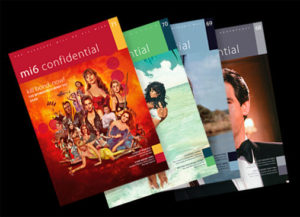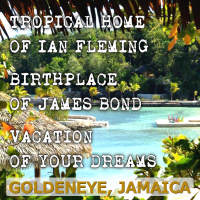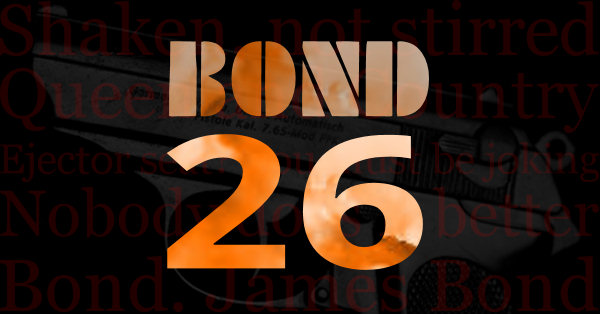Exploring the iconic vehicles of Roger Moore’s stint as James Bond.
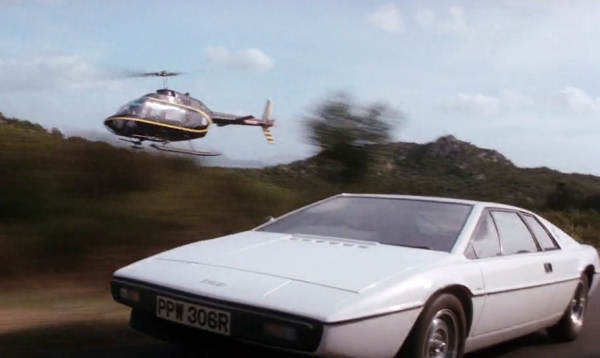
The cars from Roger Moore’s James Bond films were a varied bunch. The Lotus Esprit quickly became a Bond classic, and is the car that will always be associated with Moore’s Bond, but there were some more run of the mill choices too. Despite this, the cars in Moore’s Bond films were always exciting to watch and helped make his era memorable.
Live and Let Die
In Moore’s first Bond outing the most memorable vehicle driven by James Bond is the battered double decker bus he commandeers in San Monique.
Earlier in the film, after arriving in New York, Bond is collected by a taxi, a bronze coloured Chevrolet Impala, to go and meet Felix Leiter. As he draws his car alongside, Kananga’s henchman, Whisper, shoots the taxi driver with a poisoned dart from a dart gun concealed in the wing mirror of his car.
Bond manages to take the wheel of the taxi as it veers across the carriageway and manages to eventually steer it to safety, but he is nearly killed in the ensuing crash. Look closely and you’ll notice many of the other cars in the scene are also Impalas.
The interesting car here though is Whisper’s car. It’s a white “pimpmobile” made by Dunham Coaches from a 1971 Cadillac Eldorado and a 1968 Chevrolet Corvette. Known as a “Corvorado”, it features a long body on a short wheelbase with a large grille and V8 engine with chrome in excess. Just seven of these cars were made.
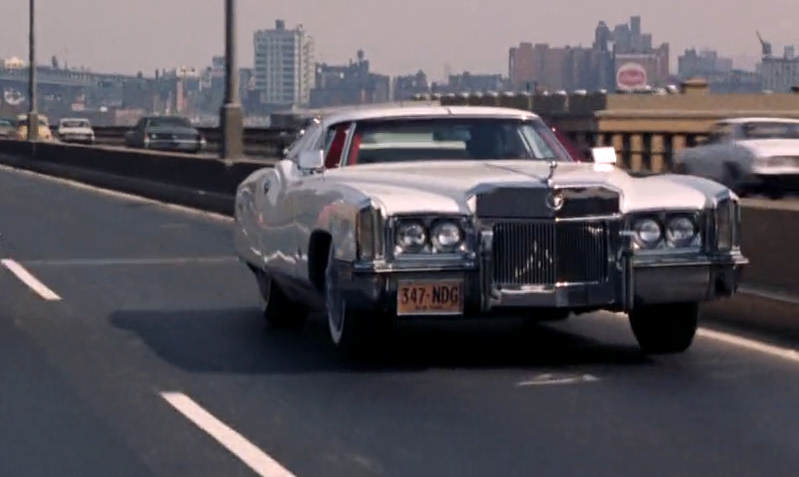
When Bond visits the Oh Cult Voodoo Shop, he enters an underground carpark after sneaking off. There he sees the Corvorado again.
He is also briefly seen driving Rosie Carver to a secluded spot in San Monique in a dusty Impala convertible after he suspects her of working for Kananga. He and Solitaire get into an Impala taxi driven by one of Kananga’s men after arriving in New Orleans. Sheriff JW Pepper’s patrol car, and most of the other police cars appearing in this scene, are – you guessed it – also Chevrolet Impalas.
Other vehicles
Now back to that bus. As Bond and Solitaire drive along coconut strewn dirt roads the local police give chase. Three motorcycle cops and two Chevrolet Nova squad cars follow them initially but they manage to unseat the motorcyclists and one of the cars. Forced onto a dirt road Bond drives under a low bridge, which tears off the upper deck. It handily disposes of the pursuing squad car in its wake too.
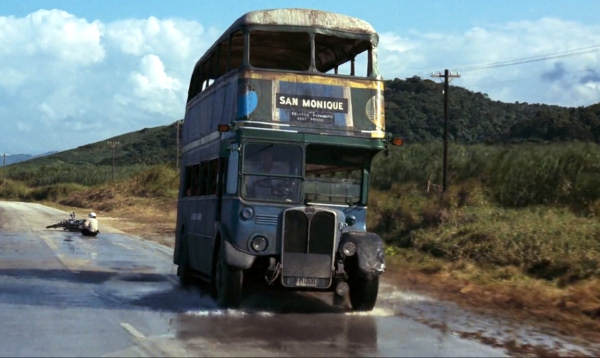
The bus is an AEC Regent III, or RT-type, produced by Associated Equipment Company (AEC) and London Transport. It was the standard red London bus in the 1950s and continued to outnumber the better-known Routemaster throughout the 1960s.
The RT-type bus was introduced in 1939, but production was slowed by the Second World War and only 150 buses were provided to London Transport between 1939 and 1942. Production restarted in 1946 with a slightly modified design and an additional 4,674 buses were supplied to London Transport. The 56 seat RT-type bus was powered by a 9.6-litre diesel engine, which gave it a top speed of around 40 mph.
Other notable means of transport for Bond in Live and Let Die include the hang glider, which he uses to infiltrate Solitaire’s home. The film was made around the time that hang gliding first started to become popular. Bond also gets behind the controls of a Cessna 170A. It begins with Bond being chased by Kananga’s henchmen through the hangar at The Bleaker Flying School.
After escaping from the crocodile farm Bond steals a Glastron GT-150 speedboat. The boat chase that follows is one of the most famous in the James Bond franchise. 26 Glastron boats were used in the filming of the scene, 17 of which were destroyed.
The Glastron GT-150 is a fibreglass-hulled speedboat introduced in 1972 and powered by a 150 horsepower Mercury outboard motor. The boat could reach speeds of up to 50 mph.
The Man With the Golden Gun
After Mary Goodnight is captured by Scaramanga and Nick Nack, Bond and Lieutenant Hip are stranded. She has the keys to Hip’s Mercedes. While Hip tries to wave down a taxi, Bond goes into a nearby AMC dealership.
Sitting in the passenger seat of a1974 AMC Hornet X hatchback is one Sheriff JW Pepper as Bond climbs into the driver’s seat and – “how about a demonstration, boy?” – drives the car straight through the showroom window and onto the road in pursuit.
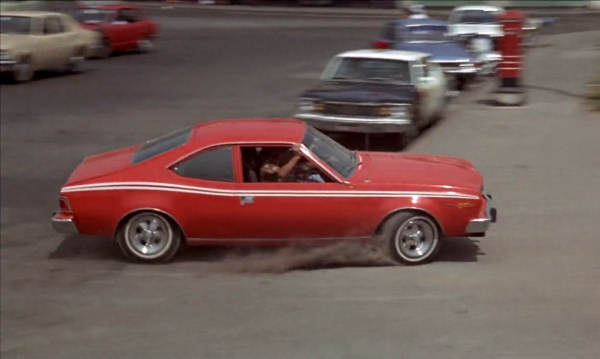
The high speed car chase that ensues is similar in vein to the speedboat chase from Live And Let Die – and the car chase in Diamonds Are Forever, for that matter – as Bond picks up a police tail, while Scaramanga floors the car when he realises Bond is on his tail.
Eventually Bond takes a wrong turn and finds himself on the wrong side of a river, separated from the other bank by the broken remains of a rickety wooden bridge. Bond lines the car up and stamps on the gas pedal in one of the best stunts of the entire series, as he corkscrews the car across the river. Shame about that slide whistle.
The stunt was performed by stuntman Lauren “Bumps” Willert in a modified Hornet after it was planned and tested as a computer simulation by Cornell Aeronautical Laboratory. The simulation showed that the stunt was possible, but it would require a very precise jump. Willert was able to perform the jump perfectly, and the stunt was filmed without any problems in a single take.
Other vehicles
While Bond tails Andrea Anders in Hong Kong, he watches as she leaves the hydrofoil terminal and gets into a green Rolls-Royce. Just as he gets into a taxi, Mary Goodnight pulls up in her mustard coloured MGB. “All green Rolls-Royces belong to the Peninsula Hotel”, she tells him.
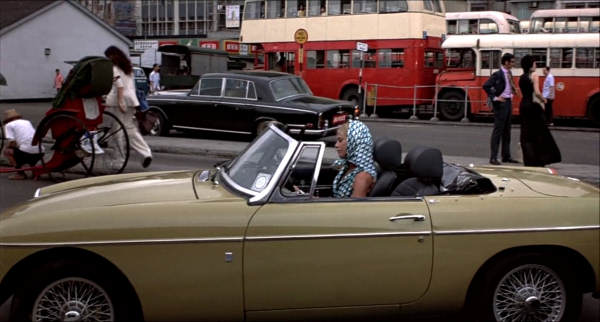
Later he is bundled into the back of an unmarked Mercedes-Benz 200 in black by Lieutenant Hip, followed by a police launch as he is taken to the wreck of the Queen Elizabeth where he is greeted by M and the MI6 posse. After visiting Hi Fat, disguised as Scaramanga, Bond is met by Hip. This time he drives a similar car in white.
In Bangkok, Mary Goodnight is waiting outside a Muay Thai stadium while Bond is inside, where he is supposed to meet Andrea Anders. As she attaches a homer inside the boot of Scaramanga’s AMC Matador, he sneaks up and bundles her in. Alerting Bond on the radio leads to the film’s great car chase, which ends when Scaramanga drives into a barn.
Bond arrives just in time to see that wings and a jet engine have been attached to the roof of the car as it takes off. Mary opens the boot to find she is in the air.
After escaping the karate school, Bond takes a longtail speedboat on the klong to escape the martial arts school heavies, who pursue him in a six-main longtail. Common in Thailand and other areas of Southeast Asia, longtail boats are powered by an outboard car engine with a propeller mounted on a long shaft that extends out from the stern of the boat giving the boats their name.
James Bond arrives on Scaramanga’s island in a RC-3 Seabee seaplane. He tracks Goodnight’s homing beacon to the island, which is located in the Red Chinese waters. The island is a remote and heavily fortified location, and Bond is able to land his plane without being detected.
At the end of the film Bond and Goodnight depart Scaramanga’s island on the assassin’s three-masted traditional Chinese junk. Seen at various points in the film, the vessel is the June Hong Chain Lee, a Malaysian junk built in 1962 and originally used as a merchant cargo vessel.
The Spy Who Loved Me
Roger Moore’s third Bond film is a firm fan favourite and remembered for introducing, in the sleek shape of a white Lotus Esprit S1, one of 007’s most outlandish gadgets ever. While escaping Stromberg’s heavies, Bond and Anya are chased to the water’s edge by a black Bell 206 JetRanger helicopter piloted by Naomi.
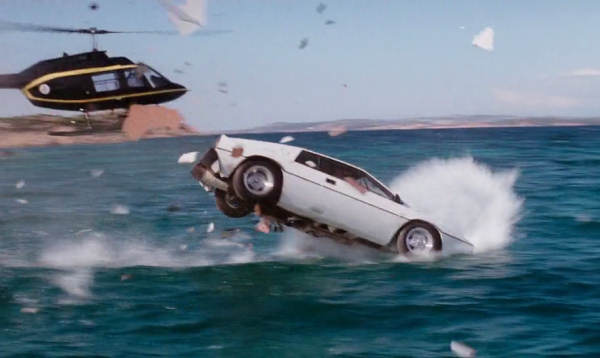
Bond drives the Lotus at high speed off the edge of a wooden pier and into the water. At the flip of a switch the car transforms into a submersible and, after using rear mounted surface to air missiles to destroy the helicopter, the pair make their escape underwater. Along the way they survey Atlantis and dispatch more Stromberg heavies using the car’s torpedoes. The car eventually surfaces on a beach, to the disbelief of all those there. Nicknamed “Wet Nellie” by the production crew, after Little Nellie in You Only Live Twice, this amphibious marvel wowed audiences and remains a fan favourite.
The iconic Esprit was designed by the renowned Italian automotive designer Giorgetto Giugiaro, who gave the Esprit its distinctive sleek, futuristic appearance. The Esprit’s body was crafted from lightweight fibreglass, contributing to its agility. Its unique wedge-shaped design made it aerodynamic and visually striking and a 2-litre, 4-cylinder engine provided a top speed of around 135 mph (217 km/h).
Other Notable Vehicles
Bond arrives at Atlantis on a wetbike, distinct from a jetski in that it is more like a motorcycle. The wetbike ridden by Roger Moore in the film was the prototype developed by Nelson Tyler and manufactured by Spirit Marine between 1978 and 1992. It is the first appearance of a wetbike on film.
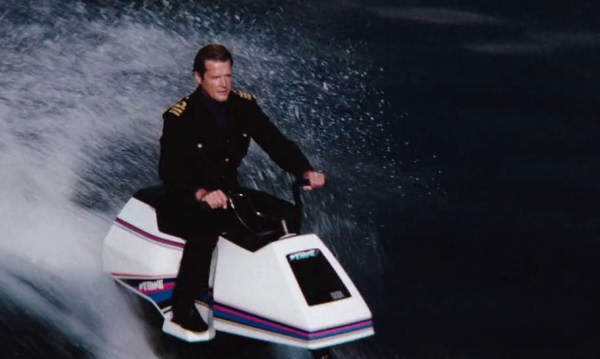
The other notable vehicle is Stromberg’s supertanker, the Liparus. The enormous vessel is equipped with bow doors that open to allow it to swallow submarines. A 20 metre model was used for scenes of the tanker at sea, while interiors were shot on the 007 Stage at Pinewood, built specially for this film.
Moonraker
After the success of the Lotus Esprit in The Spy Who Loved Me, it’s a little surprising it didn’t make a cameo in Roger Moore’s fourth 007 outing. But in 1977 Star Wars hit the big screen with the same force Dr No had done 15 years earlier and Cubby Broccoli wanted a slice of space action for himself. The result is a film in which all other means of transport were dominated by the Moonraker space shuttles, beating NASA’s own launch by almost two years.
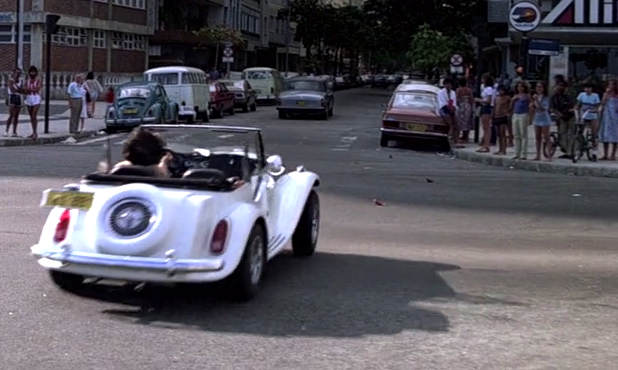
In fact there are no major sequences involving cars in Moonraker. Instead there is a chase sequence along the canals of Venice, culminating in Bond’s gondola converting into a hovercraft in St Mark’s Square – complete with double taking pigeons. But there are a couple of cars worth mentioning, even if they aren’t in starring roles.
Bond is chauffeured to and from Drax’s shooting party in a 1936 Hispano-Suiza J12 Cabriolet with coachwork by Saoutchik. His arrival is announced by a bugle sounding the notes to Richard Strauss’s Also Sprach Zarathustra, the theme from 2001: A Space Odyssey.
After arriving in Rio de Janairo aboard an Air France Concorde, Bond is driven to his hotel in a Rolls-Royce Rolls-Royce Silver Shadow dating from the mid-1970s. He is tailed by a woman – later revealed to be his MI6 contact, Manuela – in a MP Lafer, a Brazilian fibreglass-bodied car inspired by classic British sports cars with chassis, powertrain, steering and suspension from the VW Beetle.
Another vehicle worth mentioning is the gadget packed Glastron CV23HT speedboat in which Bond approaches Drax’s Amazonian lair. He is pursued by Drax’s men, including Jaws, in Glastron SSV-189s. As Bond’s boat approaches a waterfall he takes to the air using a hang glider.
For Your Eyes Only
After the excesses of Moonraker, the 1981 follow up is a much more grounded adventure taking its inspiration from two short stories, For Your Eyes Only and Risico. Not only was Bond firmly back on Terra Firma in For Your Eyes Only but he’s back behind the wheel.
Two different Lotus Esprit Turbos appear in the film and there is a big car chase sequence. But rather than racing a Lotus along the dusty roads among the olive groves in Spain, it is Melina Havelock’s yellow Citroën 2CV which gets the star treatment for a rather more affordable Bondmobile.
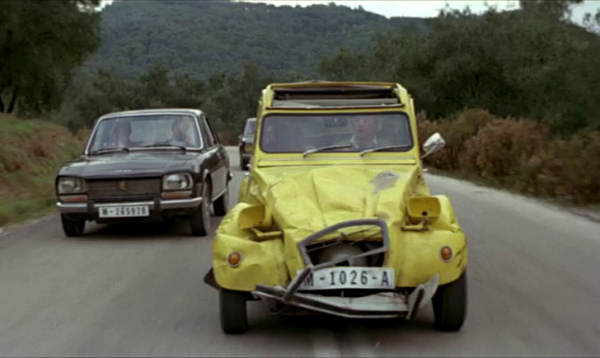
Bond arrives at the villa of a Cuban hitman Hector Gonzales in a white Lotus Esprit. He’s there to find out who hired Gonzales to kill marine archaeologist Sir Timothy Havelock and his wife. They had been attempting to locate the wreck of a British spy ship for the British government. On the car window is a sticker indicating the car is “burglar protected”.
Bond watches as Gonzales is shot by a crossbow while diving into the pool. The shooter is none other than Sir Timothy’s daughter, Melina, but as Bond leads her to his car it explodes when one of Gonzales’s guards breaks a window. Burglar protected indeed!
Instead they make their escape in her car, a Citroën 2CV, along dusty country roads, along the narrow streets of an old village (where it gets righted by the locals after flipping onto its side) and through pine covered hills while navigating hairpin bends at high speed as they attempt to out run two Citroën 504s in hot pursuit. Initially Melina takes the wheel, but after the car is righted Bond is driving.
The 2CV was first introduced in 1948 and remained in production until 1990. It was intentionally designed to be basic and practical, created as an affordable and utilitarian car for the masses, featuring a small, air-cooled engine. Its simple and rugged design made it a practical and affordable choice for rural transportation, particularly for farmers. On those roads, it was almost certainly a better escape vehicle than Bond’s Lotus.
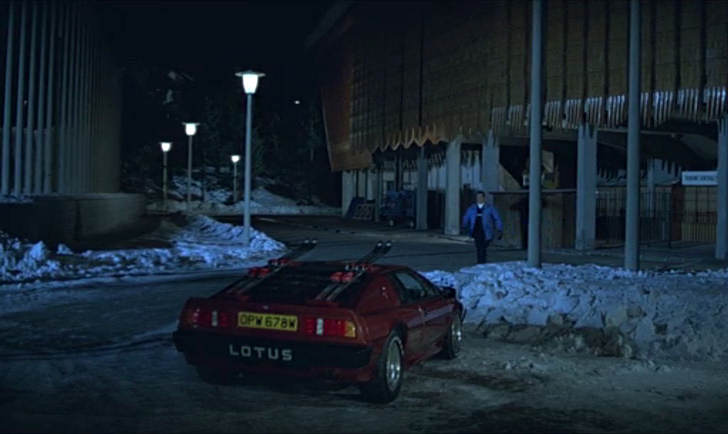
Back in London, and with the help of Q, Bond identifies a man he saw pay Gonzales while in Spain. He is Emile Locque, currently in the Italian ski resort of Cortina d’Ampezzo. Bond arrives there in another Lotus Esprit in copper with two sets of skis attached to the rear. The car is sadly underused. Two Esprits were used in filming, painted white for the earlier scenes and resprayed for the shoot in Cortina.
Other vehicles
While in Cortina skiing, Bond is chased by two goons on Yamaha XT-500 motorbikes. They are fitted with snow tyres – and machine guns. Also in Italy, Locque drives a beach buggy along the beach, hitting Countess Lisl von Schlaf and narrowly missing Bond.
After raiding Kritatos’s warehouse in Albania, Locque attempts to escape in a Mercedes 450 SEL. When Bond shoots him, Locque crashes his car, leaving it perched precariously on the edge of the cliff. In Roger Moore’s most ruthless moment as 007, he kicks the car, which falls onto the rocks below.
Octopussy
Roger Moore’s sixth outing as 007 is another Bond film without a hero car – the closest we get to that is a tuk-tuk. That’s not to say there aren’t any interesting vehicles in the film though. Not all of them are road vehicles though – they include a home built micro jet and a submersible crocodile – and one of the car sequences takes place on rails anyway!
Bond arrives at an airbase somewhere in South America in an open top Range Rover. The car is towing a horsebox. Later, after escaping with the help of his local contact Bianca, Bond unhitches the horsebox from the moving car. The rear end of a dummy horse flips up and out comes a tiny jet with its wings folded up.
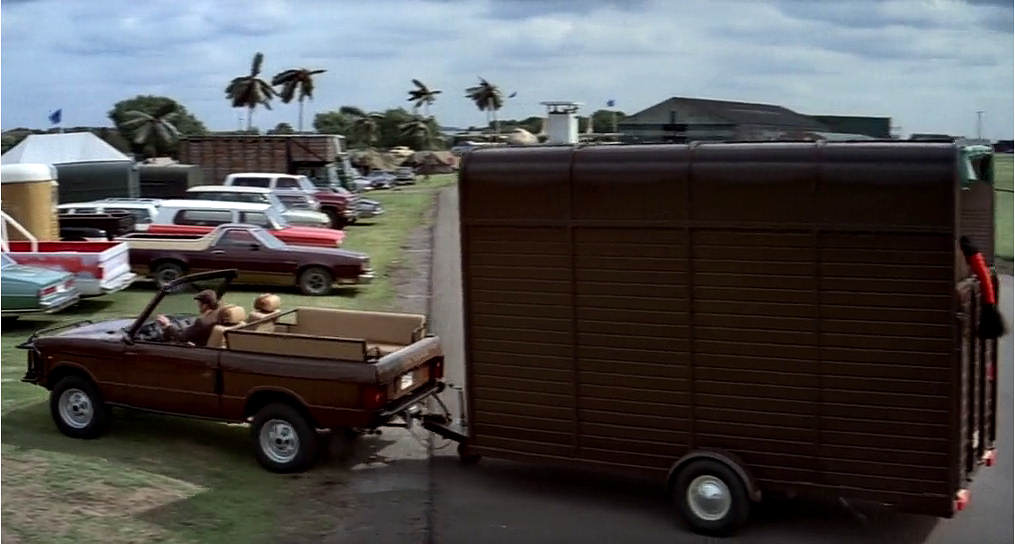
The Range Rover is relatively interesting as you don’t see too many convertibles. However, the plane is a Bede BD-5J “Acrostar” micro jet. These were supplied as self-build kits by Bede Aircraft Corporation and the one used in Octopussy was owned by Budweiser and used in beer commercials. A mockup with folding wings was used to exit the horsebox, as well as when Bond pulls up at a gas station. The aerial sequence was filmed in Southern Utah, with “Corkey” Fornof at the controls.
When Bond notices that the tuk-tuk driven by Vijay is being tailed by Gobinda, Vijay tells him “No problem, this is a company car”. Flooring the throttle the front of the tuk-tuk rears up as it accelerates away on two wheels and then, back on three wheels, along a passageway and jumping stone steps.
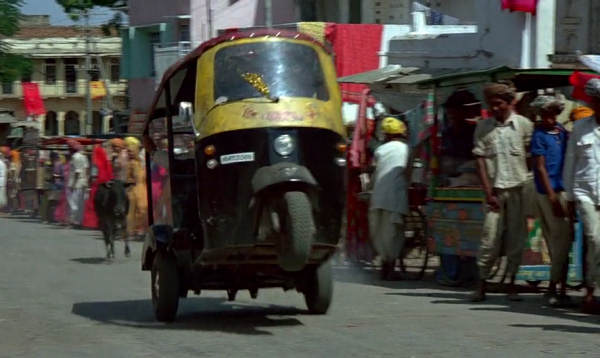
The tuk-tuk used in the movie was built upon the frame of a 1982 Honda 250R ATC three-wheeler with an uprated engine and driven by stunt driver Remy Julienne.
Other cars
In East Germany, Bond escapes from General Orlov and his troops in Orlov’s own Mercedes 250SE limousine. At a roadblock set up at a level crossing the car’s tyres are shredded, so Bond steers the car onto the tracks and pursues the circus train, leaping into it to avoid a head-on collision with a train coming the other way.
Across the border in West Germany, Bond hitches a ride from a couple driving a white VW Beetle. It’s a classic design with a rear-mounted air-cooled engine, with 21 million manufactured between 1938 and 2003. They were a pig to drive though – I used to own one – as the lack of weight on the front resulted in unresponsive steering. As they drive the couple tuck into some kind of wurst washed down with beer, which Bond declines.
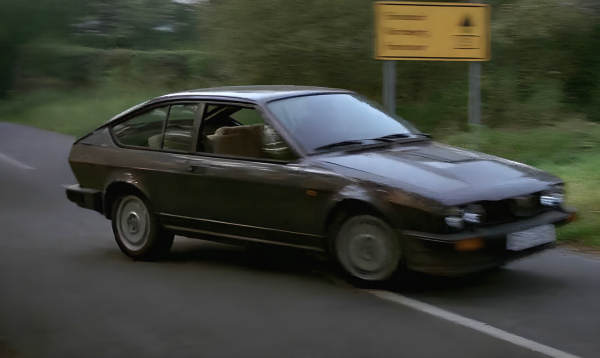
After being dropped in a town square, Bond impatiently waits to use a pay phone as the woman using it refuses to get off. Instead Bond speeds off in her car, a bronze-coloured Alfa Romeo GTV6, heading for the circus at the US air base. The local police in BMWs join the chase almost immediately and continue their pursuit as Bond jumps the entry checkpoint at the base towards the circus. After ditching the car he disguises himself as a clown.
A View to a Kill
Once again in the Roger Moore era, 007 lacks an MI6 provided car. That doesn’t stop the film from two elaborate chase scenes though, one on the streets of Paris and the other, involving a Fire Truck racing through the streets of San Francisco.
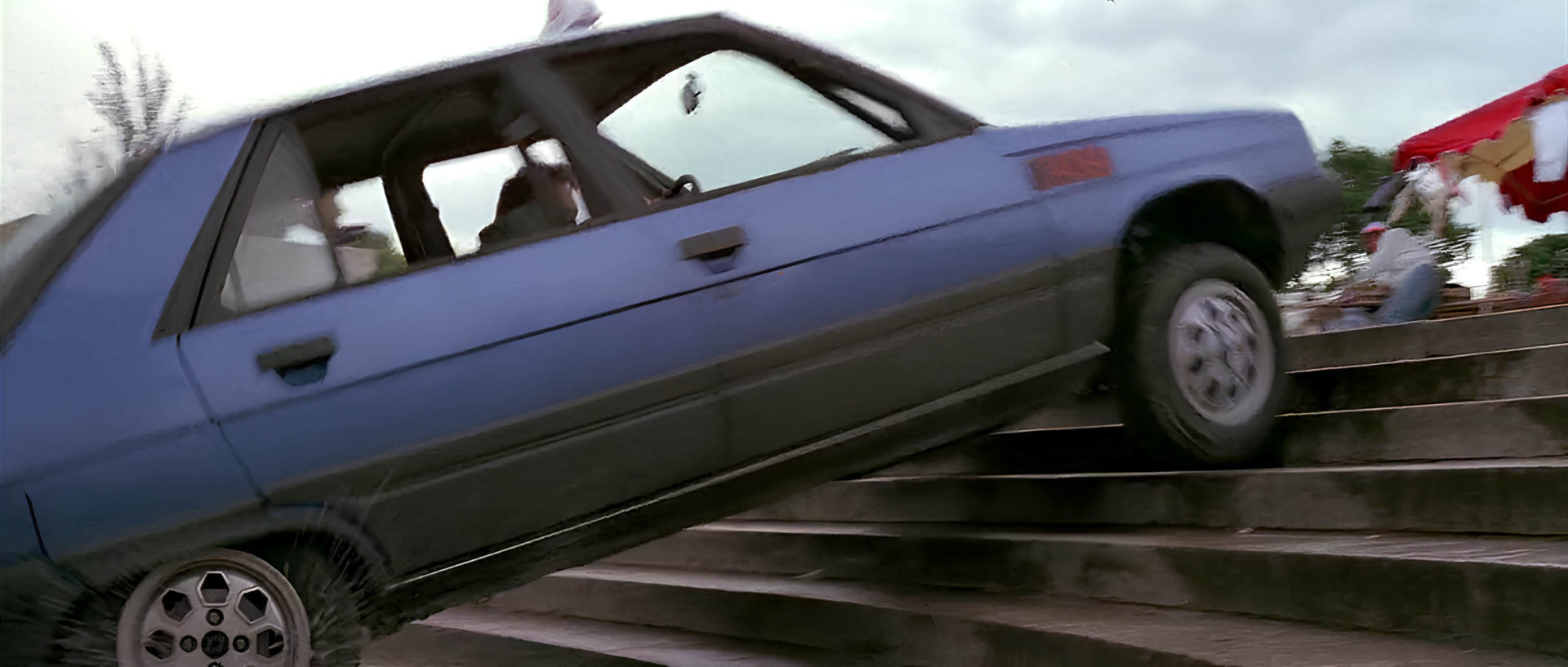
The first major chase sequence takes place when Bond commandeers a blue Renault 11 taxi waiting at the bottom of the Eiffel Tower. He drives the car down steps, jumps it onto the top of a double decker tourist bus, decapitates it by driving through a barrier and, after being struck by another car, loses the rear end completely as he pursues May Day, sailing across the Paris skyline by parachute. It’s almost plausible in a Renault 11 due to front-wheel drive, although you have to ask where the fuel was coming from!
French stunt driver and stunt coordinator Rémy Julienne was responsible for planning and executing the sequence. Modified cars were equipped with safety features to protect the stunt driver and ensure a controlled environment for the manoeuvres, which were meticulously choreographed.
The Renault 11 was produced from 1983 to 1988 in various body styles. The car in the film is a 5-door hatchback. Known for its practicality and fuel efficiency, The Renault 11 was a popular choice among European drivers.
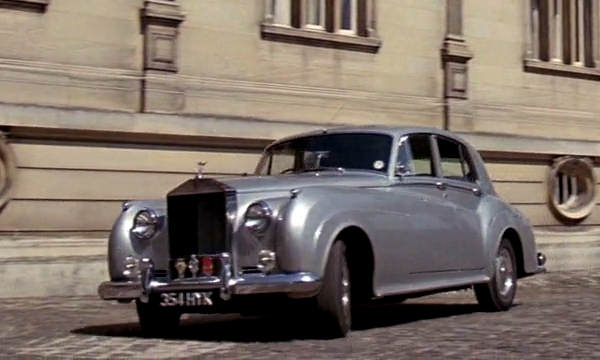
Bond is assisted in the film by Sir Godfrey Tibbet, who drives a Rolls-Royce Silver Cloud II. The car was actually owned by producer Cubby Broccoli. As Sir Godfrey takes it to a carwash Jenny Flex, driving a Renault Fuego watches on. After Sir Godfrey is killed and Bond knocked unconscious, May Day drives them to a lake. She and Zorin watch it sink with Bond and the late Sir Godfrey inside – presumably Cubby’s car wasn’t used in this shot! Naturally Bond is able to escape.
The Rolls-Royce Silver Cloud II was produced between 1959 and 1962. The epitome of automotive luxury, it featured a refined 6.2-litre V8 engine producing 185 horsepower, mated to a 4-speed automatic transmission. Known for its elegant body design, the car boasted a plush suspension, power-assisted drum brakes, and an opulent interior. It remains an enduring symbol of timeless luxury in the classic car world.
Other vehicles
Okay, not a car but I’ll mention it as it is involved in the major chase sequence of the film. Bond and Stacey escape the police in a San Francisco Fire Department American LaFrance Ladder Truck. Bond soon lets Stacey behind the wheel as he clambers out and onto the ladder, which swings wildly as the truck swerves along the city streets. With Bond back behind the wheel the fire truck leaps a drawbridge as it opens, losing the police cars that are tailing them.
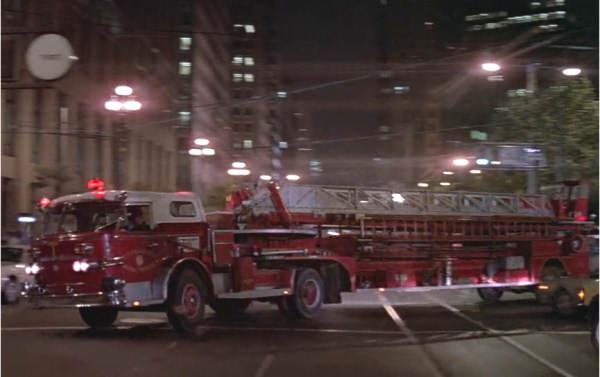
Founded in 1832, the American LaFrance Fire Engine Company played a significant role in the development of fire trucks and ladder trucks. The ladder trucks were equipped with extendable ladders designed for firefighters to access to upper floors of buildings. The company ceased production in 2014 after financial difficulties, marking the end of an era for this once-prominent fire apparatus manufacturer.
There are a number of other cars with bit parts in A View to a Kill. Russian agent Pola Ivanova drives a white Chevrolet Corvette C4. Stacey Sutton is behind the wheel of a State owned Jeep Cherokee, intercut with Bond driving a Ford LTD, as both head to her house in California and Chuck Lee joins them later in a Ford Bronco.



